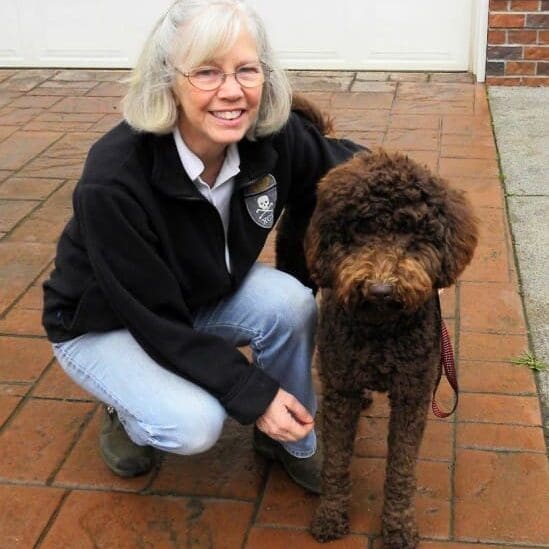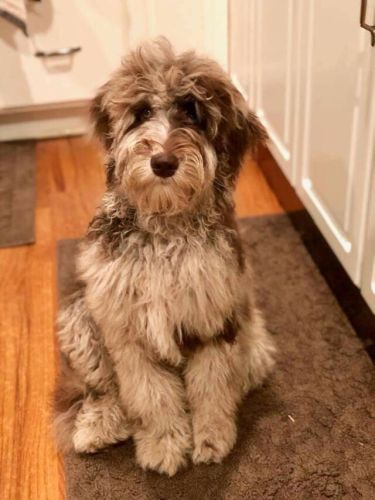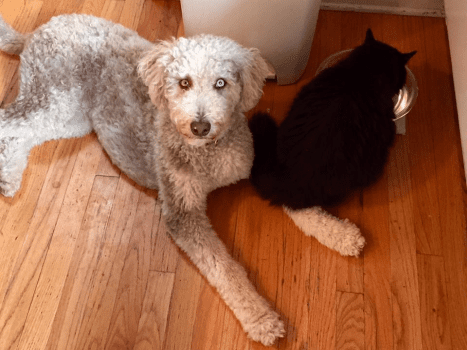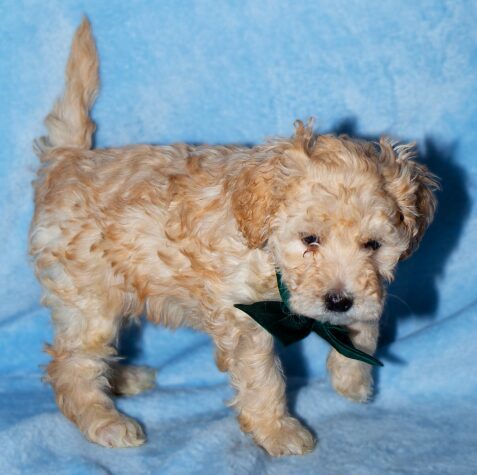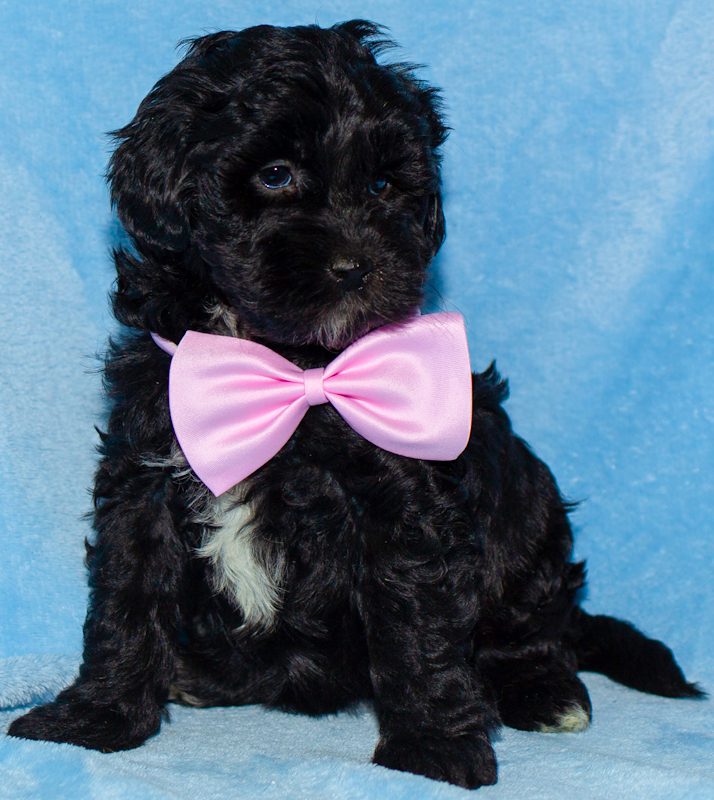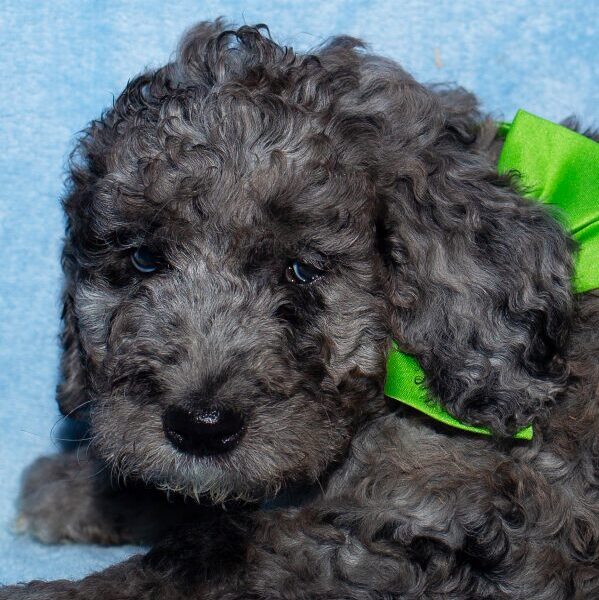What You Should Know About Labradoodles
- Temperament: Loving, intelligent, athletic and energetic, Labradoodles are friendly with people and other dogs as well as cats but can develop separation anxiety if left alone too often, will adapt better if they have another dog family member.
- Exercise: They are active dogs that require regular exercise, like walks, fetch, or other outdoor activities.
- Training: Easy to train with positive reinforcement, as they are eager to please and highly intelligent.
- Shedding: Low-shedding and allergy-friendly
- Size: Available in mini, medium, and standard sizes.
- Coat Types: Labradoodles have various coat types, most of which shed minimally to zero.
- Grooming: Regular brushing and grooming are necessary to maintain their coat quality, comfort and to avoid matting.
The Australian Labradoodle
An Australian Labradoodle is a cross between a Labrador Retriever, Poodle, and Cocker Spaniel. They are known for being intelligent, social, and good with families.
The Australian Labradoodle, was developed by an Australian breeder over 30 years ago, and is a carefully guarded mix of several different breeds including the Labrador-retriever, poodle, English cocker spaniel, American cocker spaniel, and Irish water spaniel.
The goal of this breeding was to create a service dog with the Labrador’s friendly temperament and the Poodle’s hypoallergenic coat.
- Coat: Low odor and low- to no-shedding
- Exercise: Require daily exercise, such as walks or obstacle courses
- Grooming: Need regular grooming to prevent tangles
- Size: Miniature, medium, and standard sizes
- Temperament: People-focused, intuitive, intelligent, and love people
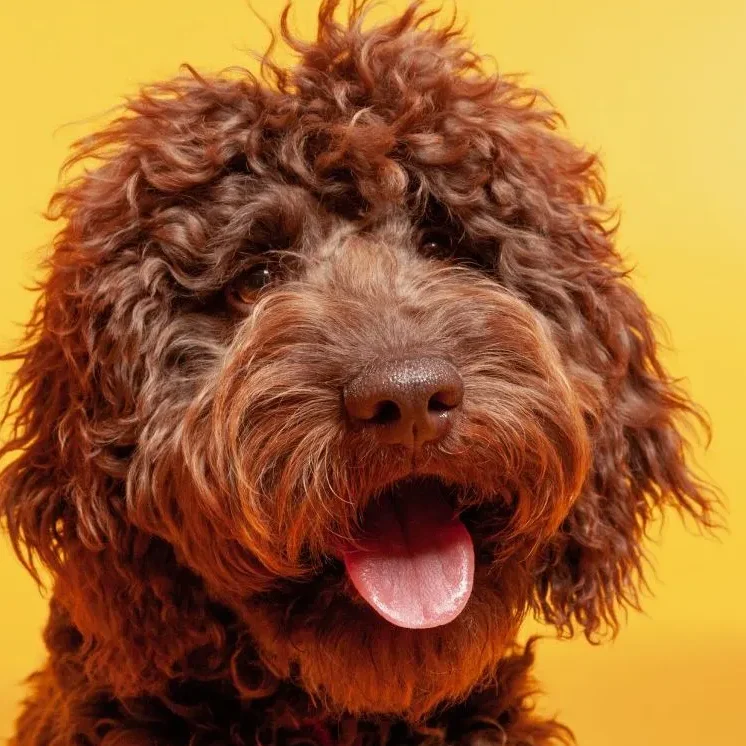
Coat types:
- Wool and fleece coats: Tend to shed very little and are good options for families with allergies.
- Hair coats: May shed more, similar to other dog breeds.
Are all Labradoodles Non-shedding?
No, not all generations of Labradoodles are considered to be low-shedding because the coat type varies by generation and breeding (wavy, curly, or straight) for example the F1 Labradoodle is the most inconsistent when it comes to shedding but the higher generation Labradoodles are almost always considered to be very low-shedding to non-shedding dogs.
Grooming:
- Regular maintenance is essential
- Brush your Labradoodle twice a week
- Take your Labradoodle to the groomer’s two to four times per year
Labradoodle Generations:
First generation Labradoodles: Most first generation Labradoodles shed and may cause allergy symptoms.
Australian Labradoodles: Australian Labradoodles are generally non-shedding, but it depends on the coat type and whether the parents and grandparents are non-shedding.
Multigenerational Labradoodles: Multigenerational Labradoodles are typically non-shedding if both parents are non-shedding.
F2 Labradoodles: F2 Labradoodles usually have the most unpredictable coats and shedding, but it still depends which traits they’ve inherited from their parents and grandparents.

Dreamydoodles Australian Labradoodles have either a fleece or wool coat type which are the 2 best options if you suffer from pet allergies. We’ve had lots of customers who have pet allergies and who have also reported zero issues with their Dreamydoodle dogs which is the best review I could ask for as a Labradoodle breeder!
Hypoallergenic?
While Labradoodles may be more allergy-friendly than some dog breeds, no dog breed is completely hypoallergenic. Prospective owners should conduct thorough research, consider their allergy tolerance, and spend time with Labradoodles to make an informed decision before adopting a Labradoodle puppy.
More In-depth Explanation:

Key points to consider:
- Similar traits: Both male and female Labradoodles are known for being affectionate, intelligent, playful, and highly trainable.
- Slight size difference: Male Labradoodles tend to be slightly larger than females.
- Individual variations: While gender may not be a deciding factor, each Labradoodle will have its own unique personality, so it’s important to choose a puppy based on its temperament and how it interacts with your family.
Is it better to have a male or female Labradoodle?
According to most breeders and dog experts alike, there’s really no significant difference in temperament between the male and female Labradoodles, meaning both genders can be equally good pets; the key factor is the individual dog’s personality and how well it’s raised and trained, not their sex.
There’s NO clear difference between male and female Labradoodles when it comes to their personality.

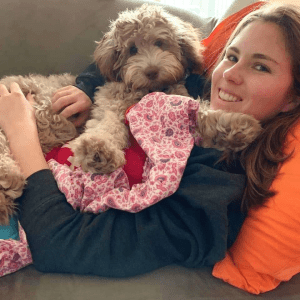
Labradoodles usually come in three main sizes Mini, Moyen (medium) and Standard (we no longer breed the Standard size anymore) Different breeders will produce different size ranges depending on their parent dogs.
Labradoodle Sizes:
Do Labradoodle get along with other pets? Like Cats? Dogs?
If you’re a multi-pet, multi-species household, you’ll be happy to hear that Labradoodles generally get along just fine with other dogs and, yes, even cats.
Labradoodles can absolutely get along with cats. Labrador Retrievers and Poodles are laidback and easy-going breeds, so they can learn to live alongside your feline family members under the right circumstances. Slow introductions are best at least for the cats sake.
Dreamydoodles and Their Cat Freinds
Our Labradoodles and Aussiedoodles both are well known for their friendly and loving temperament.
They are known to be social dogs who enjoy the company of both humans and other animals. Their friendly nature makes them great family dogs and ideal for households with children and other pets.

Labradoodles are active dogs and need at least 30-60 minutes of daily exercise, including walks, playtime, or mental stimulation. This can be split into multiple sessions or multiple walks.
Exercise types: Walks, Runs, Fetch or frisbee, Swimming, Agility training, Puzzle toys, and Obedience training.
Exercise for puppies: Short, controlled play sessions and Gentle walks. You should avoid excessive exercise like jogging with your puppy until fully grown.
Too much exercise can cause bone and joint issues. Also avoid letting them run or slide around on on hardwood floors or surfaces, put down rugs
Mental stimulation: Labradoodles also need mental stimulation. Training, puzzle toys, and new experiences can keep their minds active.

Labradoodle training:
- High trainability: They are a mix of Labrador Retrievers and Poodles, both known for their intelligence, making Labradoodles highly trainable.
- Positive reinforcement: Respond best to reward-based training with praise and treats.
- Early socialization: It’s important to socialize your puppies from a young age to prevent behavioral issues.
- Mental stimulation: Labradoodles thrive on mental challenges and enjoy learning new tricks.
- Puppy classes: Enroll your puppy in a puppy training class to give them a solid foundation and get them started on the right paw.
Enroll in a Puppy Class

If You Want a Good Dog…
you must train your puppy!
Every breed of dog needs basic training! I highly recommend a local puppy class—even if you’ve raised puppies before!
Puppy classes refresh, enhance and strengthen your dog training skills and provide valuable socialization opportunities for your puppy, having a scheduled time each week dedicated to just training your puppy will help keep busy families consistent.
Your local PetSmart and Petco offer accredited, weekly puppy training classes that encourage positive training and consistent behavior, helping you raise a well-mannered puppy.
Visit your local PetSmart or Petco for details on class availability, schedules, and pricing.
Puppy Training Classes:
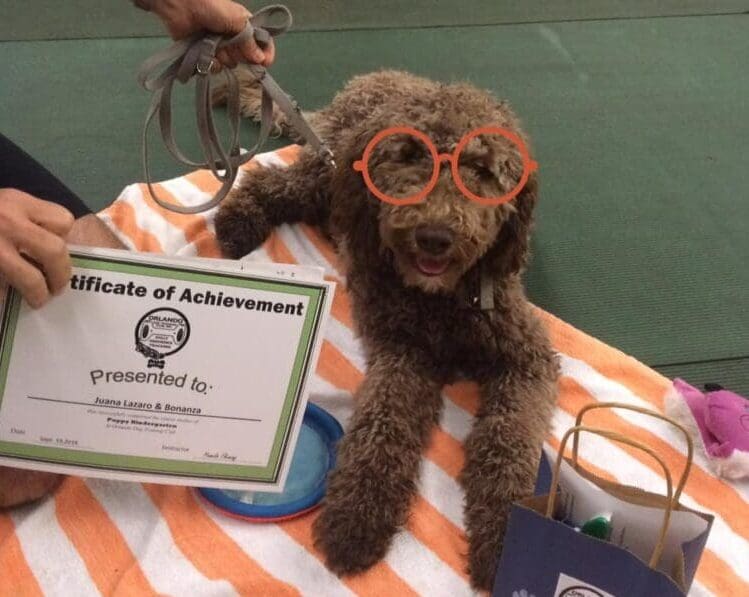
What to Teach Your Puppy
Top 5 most important skills/cues you need to teach your puppy first:
Training “come” and “sit” are usually the first and easiest, because these are natural behaviors your puppy will do regardless, the trick is catching the behavior and then pairing it with a cue word and a reward.
- McCann Dog Training on YouTube can also help you! This is one of the few Youtube channels I’ll recommend for puppy training!
- Yorkshire Canine Academy Youtube Channel Effective training tips and offers an online course as well
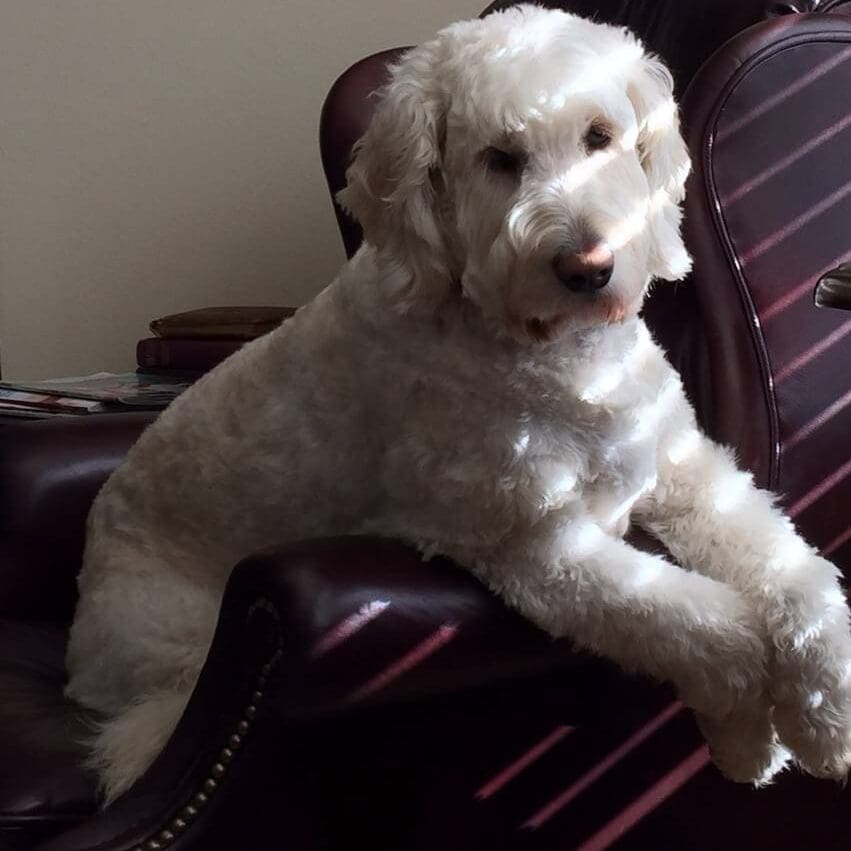
Labradoodle: Average Life Span
The average lifespan of a Labradoodle is 12 to 15 years. This is similar to the lifespan of their parent breeds, the Labrador Retriever and the Poodle.
Factors that affect lifespan
Genetics: A Labradoodle’s lifespan can be affected by genetics. For example, hip dysplasia is a common concern in Labradoodles.
Diet: A nutritious and balanced diet can help a Labradoodle live a long life.
Exercise: Regular exercise and mental stimulation can help keep a Labradoodle fit and sharp.
Health care: Regular veterinary care can help a Labradoodle live a long life.
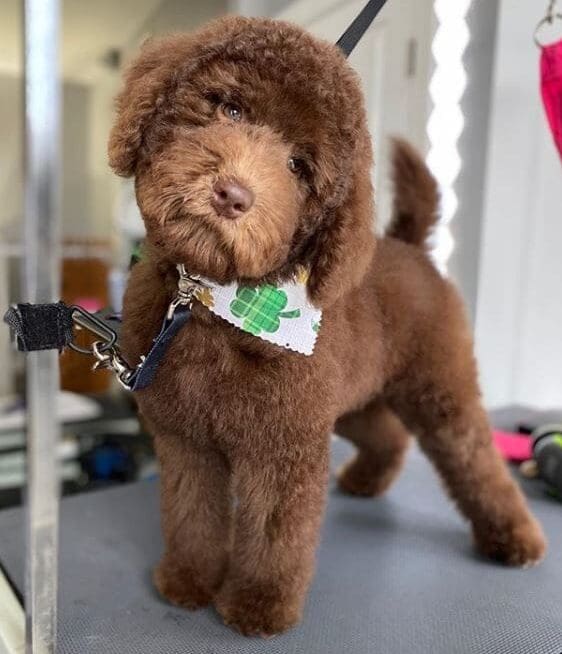
How often do you need to groom a Labradoodle?
A Labradoodle typically needs professional grooming every 6-8 weeks to maintain a healthy coat and prevent matting, with daily brushing at home recommended between grooming sessions; the exact frequency may vary depending on the length of their coat and lifestyle.
Key points about Labradoodle grooming:
- Regular grooming schedule: Most experts recommend professional grooming every 6-8 weeks.
- Daily brushing: To prevent matting, brush your Labradoodle’s coat daily, especially important for longer coats.
- Coat length preference: If you prefer a longer coat, you may need slightly more frequent grooming.
Two great websites with all the info you’ll need to learn more about how and when to groom your Doodle!

What is special about Australian Labradoodles?
There are many different types of dog breeds in the world, but there is one breed that always seems to stand out as The Best Dog Breed: The Australian Labradoodles.
These dogs are known for being friendly, intelligent, and easy to train – making the Australian Labradoodle the best dog breed for families with children.
Australian Labradoodles, are also several generations removed from the shedding Labrador.
Over the past 35 years, their coats have been carefully developed to be non-shedding, making them also highly compatible for individuals who suffer from pet allergies or asthma.
Can Australian Labradoodles be left alone?
Australian Labradoodles are renowned for their affectionate nature and their strong bonds with their dog owner. However, this deep attachment can sometimes make them more susceptible to separation anxiety. Understanding the unique characteristics of Labradoodles can shed light on why they may experience separation anxiety more frequently than other breeds.
Labradoodles thrive on human companionship and interaction, making them incredibly loyal and devoted pets.
Their friendly and loving nature, are undoubtedly their most endearing qualities, they can also be a double-edged sword when it comes to separation anxiety. Labradoodles are often described as “velcro dogs” because they tend to stick to their owners like glue. They form strong emotional bonds and can become quite dependent on their human family members.
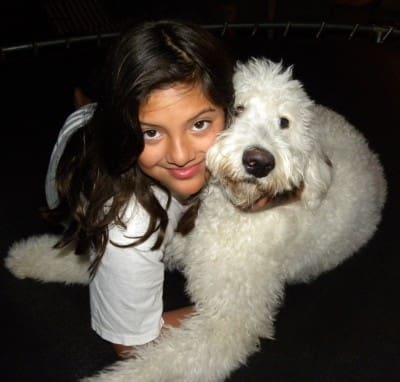
Do Labradoodles bond with one person?
Labradoodle Tend to Bond with Multiple People!
Labradoodles are VERY social, people-oriented dogs that thrive in the company of others, including other pets. They tend to bond with ALL members of their household rather than just one person, and their affection is easy to earn—sometimes,
a simple belly rub is all it takes.
Favorite Person
While Labradoodles bond with many people, they can also develop a special connection with one “favorite person,” typically the person who gives them the most attention and positive energy.

Separation Anxiety Causes:
- Boredom: Labradoodles are intelligent and can easily become bored when left alone.
- Clinginess: Labradoodles are known to be clingy and often follow their owners around.
- Schedule changes: Abrupt changes in schedule, such as when or how long a dog is left alone, can trigger separation anxiety.
Do Labradoodles have high separation anxiety?
Labradoodles are VERY social dogs that thrive on your companionship. They can develop separation anxiety if left alone for extended periods of time or are not getting enough mental or physical stimulation.
Crate training can help puppies and dogs learn to self-soothe and it’s highly recommended that you start training your Labradoodle puppy early to avoid these types of unwanted behaviors.

Debunking The Myths:
Separation anxiety in Australian Labradoodles can be a complex issue, often surrounded by myths.
Let’s clear up some common misconceptions:
Myth 1: All Labradoodles will develop separation anxiety.
Fact: While Labradoodles are affectionate and social dogs, not all Labradoodle will experience separation anxiety. Factors like temperament, upbringing, and training all play a significant role in its development.
Myth 2: Separation anxiety is just disobedience.
Fact: Separation anxiety is a psychological condition, not a behavioral choice. It stems from stress and fear, not defiance, so punishment is not an effective solution. Instead, patience and training are key.
Myth 3: Giving more toys and treats will solve separation anxiety.
Fact: While toys and treats can provide temporary distraction, they don’t address the root causes of separation anxiety. Proper training, gradual desensitization, and establishing a routine are essential for long-term improvement.

Ways to Help Prevent Separation Anxiety in Dogs
Here are some tips to avoid separation anxiety from developing in your dogs!
- Exercise: Ensure your dog gets plenty of exercise, especially before you leave. Physical activity can help your dog relax and rest while you’re away.
- Mental Stimulation: Keep your dog engaged with interactive games, such as fetch and tug-of-war, or provide food puzzle toys. You can also hide small amounts of kibble around the house or yard for a fun scavenger hunt.
- Routine: Establish consistent routines for your dog including departure and return times to help your dog adjust to your schedule.
- Crate Training: Crate training can be an effective way to help puppies learn to handle short periods without your attention in a safe and secure environment.
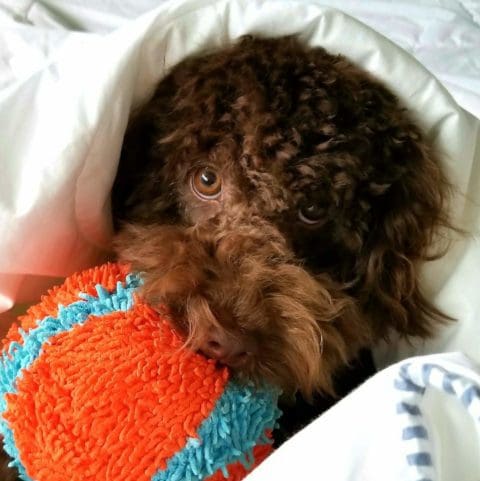
What causes of separation anxiety in dogs?
Some causes of separation anxiety in dogs include:
Some causes of separation anxiety in dogs include: genetic predisposition, lack of exercise, changes in family dynamics, traumatic experiences, being left alone for extended periods, inadequate socialization, boredom, a history of neglect or abuse, and disruptions to routine or schedule
- Insufficient exercise is probably the biggest one and can contribute to problem behaviors including destructiveness (chewing and digging), investigative behavior (garbage raiding), hyperactivity, unruliness, excitability, attention-getting behaviors, and even some forms of barking.
- A walk a day can keeps the frowns away!
- Harsh punishments, yelling, or physical corrections
- Changes to the family dynamics
- Rehoming
- A pet parent transitioning from staying home to working outside the home.
First 7 Things You NEED To Teach Your Puppy
Watch their video to learn the first seven things you need to teach your new puppy!
Available Puppies
Pictures below are our currently available puppies!
We have more on
our Available Page!
Call Us for More Info!
360-448-1477
Mini/Moyen Size – Australian Labradoodle Puppy
Mini/Moyen Size – Australian Labradoodle Puppy
Mini/Moyen Size – Australian Labradoodle Puppy
Moyen Size – Australian Labradoodle Puppy
Puppy Supplies
- Food and Water Bowls: Use stainless steel bowls, as they are more hygienic and less likely to harbor bacteria than plastic or ceramic options.
- Puppy Food: A high-quality, balanced puppy food is essential for proper growth and development, especially during their first year.
- Puppy Pads: A must-have for potty training
- Toys: Puppy-safe chew toys help with teething and provide mental and physical stimulation to burn off energy.
- Dog Bed: A comfortable bed with room to grow ensures your puppy gets restful sleep.

